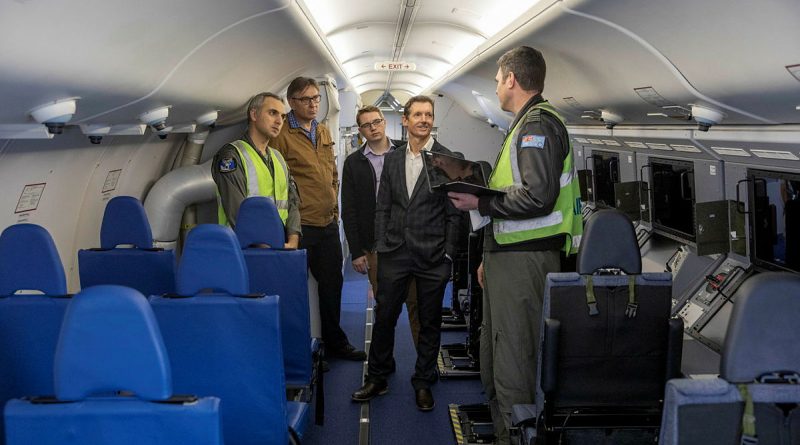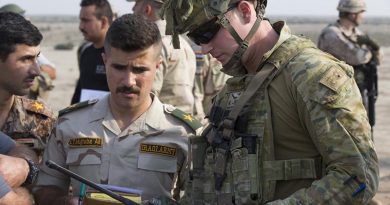New software ensures a safer flight

The Government’s focus on Australian industry capability has resulted in the delivery of an Australian-developed software Weight and Balance Tool (WBT) for Air Force’s fleet of P-8A Poseidon aircraft.
CAPTION: Squadron Leader Joshua Brown, right, describes the P-8A Poseidon airborne electronics analyst work stations to Squadron Leader Cosimo Panetta, left, and visiting contractors Peter Ryder, Adam Webber and Justin King. Story by Flying Officer Xavier Szegi. Photos by Leading Aircraftman Sam Price.
Weight and balance for the P-8A is complex due to in-flight weight changes, which result from the employment of sonobuoys, torpedos, anti-ship missiles, survival life rafts and the conduct of air-to-air refuelling.
Demand for a new WBT became critical after 11 Squadron raised a safety risk with functionality within the previous WBT software. As a result, Surveillance and Response Systems Program Office (SRSPO) initiated a tender process for a tailor-made contracted solution.
Fleet Aeronautics – a Brisbane-based software development company – was awarded the contract, having developed similar software for commercial aircraft. Fleet Aeronautics produced a bespoke application, specific to the Air Force P-8A.
Critical to the project’s success was the highly collaborative engagement between Fleet Aeronautics, P-8A operators, the US Navy, SRSPO and sustainment partners within Boeing Defence Australia and QinetiQ.
The WBT was released to 11 Squadron in December 2023 and received positive feedback from operating crews.
P-8A pilot Flight Lieutenant Jordan Cook, of 11 Squadron, said: “The improved WBT has refined how the squadron manages aircraft loading, offering enhanced accuracy and efficiency to ensure safe flight operations”.
Boeing Defence Australia P-8A technical pilot and Air Force Reserve P-8A operator Angus Wheeler said, from an operator perspective, the WBT improved safety, increased reliability and provided a simple ease-of-use solution.
“The introduction of the WBT enables crews to easily navigate and monitor the aircraft envelope during all phases of flight. This, in turn, reduces pilot workload and increases capability,” Mr Wheeler said.
P-8A aircrew feedback from in-service use of the WBT has provided a scope for version 2.0 of the application. SRSPO is currently leading the contracting effort to incorporate these version 2.0 improvements and to provide a mechanism for future agile in-service updates.
The success of Fleet Aeronautics’ WBT highlights the benefits of engaging and harnessing Australian industry to achieve a high-quality and fit-for-purpose result. This demonstrates the skills, agility and capability within Australian industry to support Defence needs.
The WBT’s success has now drawn interest from the wider international P-8A community and there is potential for it to be introduced to other P-8A fleets. This highlights that Australian industry has the skills to develop capabilities that benefit the global Defence environment.
.
.

.
.





